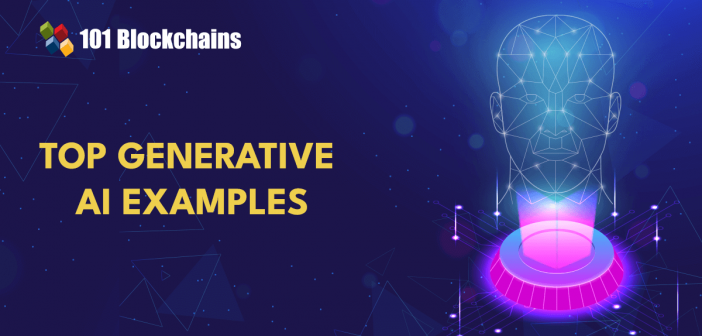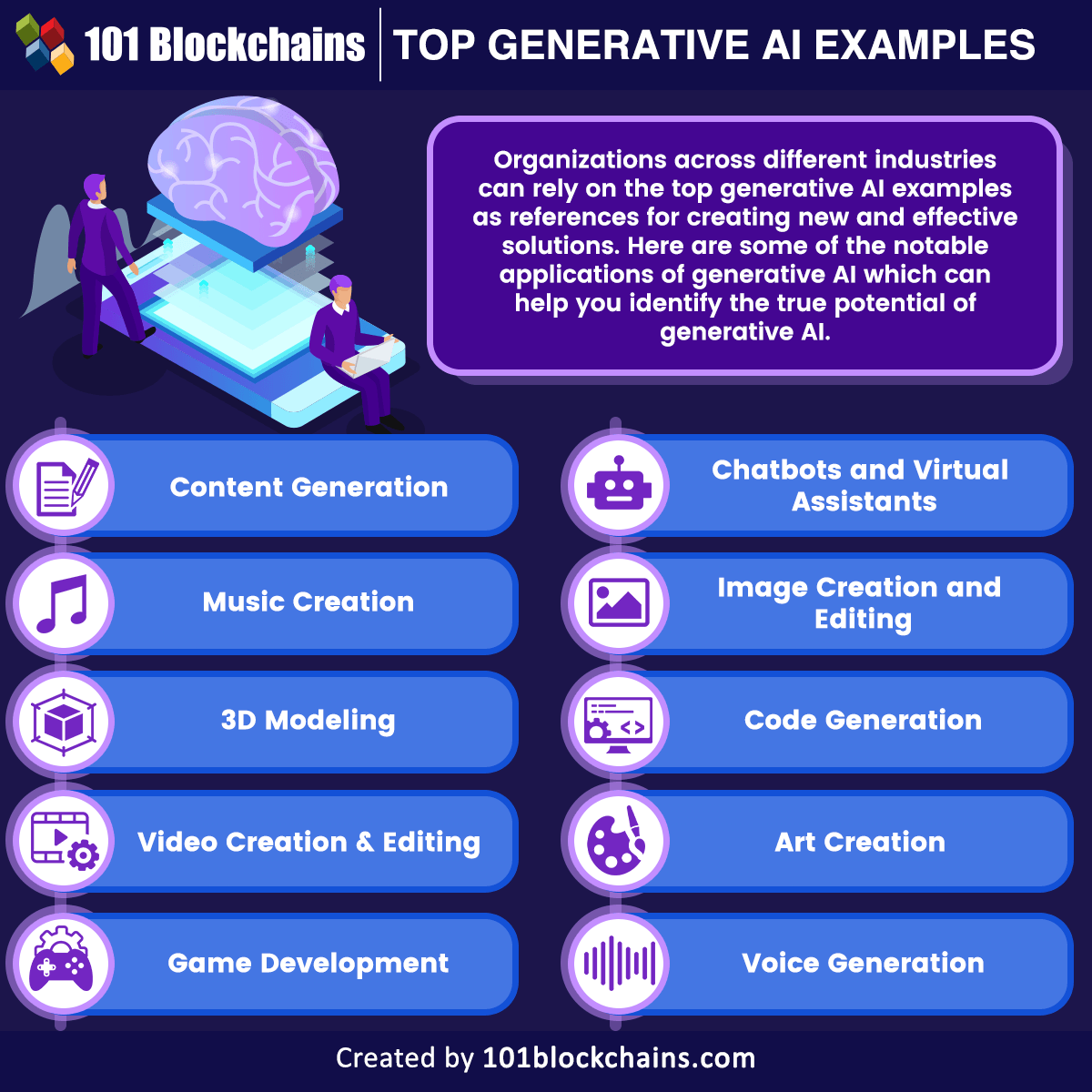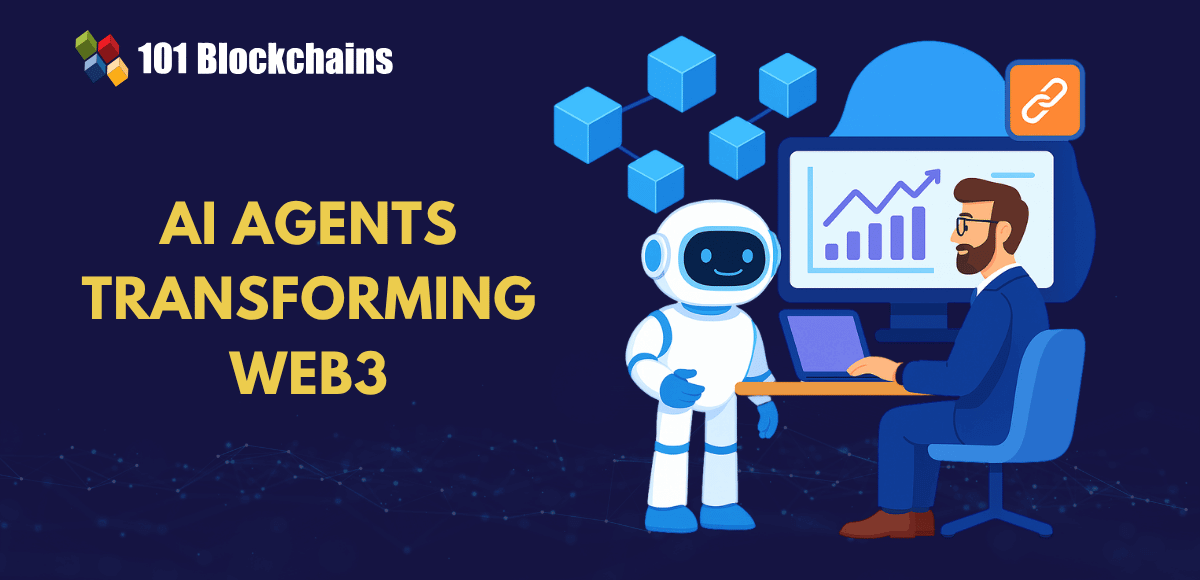Learn how blockchain truly works, master key definitions, and uncover what makes smart contracts so "smart." Dive into the fundamentals, gain valuable insights, and start your blockchain journey today!

- AI & ChatGPT
Georgia Weston
- on August 08, 2023
Top 10 Generative AI Examples
Generative AI is one of the biggest priorities for professionals interested in learning about artificial intelligence. It has transformed the domain of content creation by enabling faster production of animated, visual, and textual material. The search for top generative AI examples in different sectors has been escalating at a rapid pace. You can find uses for generative AI in multiple sectors, such as healthcare, marketing, gaming, education, and communication.
Therefore, generative AI has emerged as one of the most promising technological trends for 2023. The 2022 Emerging Technologies and Trends Impact Radar report by Gartner reveals that generative AI has massive potential for disruption. The report has pointed out that generative AI could generate around 10% of all the data alongside 20% of test data in consumer applications.
It is also important to note that the emerging applications of generative AI technology would have a noticeable impact on other industries. For example, the manufacturing industry could provide the best generative AI examples for improving product development. Furthermore, the hype around generative AI is also another promising reason to look forward to new trends in generative AI. The following post helps you learn more about the potential of generative AI with a detailed outline of top use cases of generative AI along with examples.
Understand the Basics of Generative AI Applications
Your search for answers to “What are the most popular generative AI?” should start with the definition of generative AI. You must have noticed the pace of technological transformation and the ways in which new industrial environments enable people to work with intelligent machines. The smart machines feature the capabilities of machine learning and artificial intelligence. Generative AI is a variant of artificial intelligence that relies on machine learning and deep learning algorithms for creating new text, video, images, or programming logic for different types of applications.
The most popular generative AI examples can help you understand how generative AI uses algorithms for detecting underlying patterns in the inputs. As of now, the two most popular generative AI algorithms are transformer-based models and Generative Adversarial Networks or GANs. Transformer-based models can take information from the internet and create different types of text. On the other hand, GANs work for generative multimedia and visual content from images and text.
Understand the true potential of generative AI and become an expert with the Generative AI skill path
Why Should You Learn about Generative AI Examples?
You should understand the working of generative AI models to find out their impact on the existing digital landscape. The top generative AI use cases signify that you could utilize AI models for creating unique and original content in different forms. On top of it, generative AI tools also offer the benefits of training with natural language processing and neural networks. As a result, generative AI could help in making more sense of input data for offering desired outputs to users. Generative AI models could rely on training with massive volumes of relevant, unbiased, and ethical training data to achieve better efficiency.
It is important to find answers to “What are the famous generative AI models?” as generative AI becomes a top priority for businesses worldwide. First of all, generative AI has the potential to create new data, which leads to expansion of possibilities for testing and research. Another reason to learn generative AI examples is the possibility of improving the existing algorithms by developing training data for new neural networks. On top of it, generative AI can play a crucial role in creating the next generation of intelligent machines.
Excited to learn the fundamentals of AI applications in business? Enroll now in the AI For Business Course
Notable Use Cases of Generative AI and Examples
The fundamental description of generative AI suggests that it can offer multiple value benefits to businesses and tech users. Organizations across different industries can rely on the top generative AI examples as references for creating new and effective solutions. Here are some of the notable applications of generative AI which can help you identify the true potential of generative AI.

Please include attribution to 101blockchains.com with this graphic. <a href='https://101blockchains.com/blockchain-infographics/'> <img src='https://101blockchains.com/wp-content/uploads/2023/06/Top-Generative-AI-Examples-1.png' alt='Top Generative AI Examples='0' /> </a>
-
Content Generation
The first edition among the examples of generative AI applications is content generation. Generative AI utilizes algorithms that can create content that looks like they have been created by humans. Such types of use cases of generative AI have been gaining popularity as organizations and general users look for new approaches in automation of content creation. It also offers crucial value benefits for saving time and resources.
The most popular generative AI examples in content generation focus on training machine learning models with humongous volumes of existing text from books, social media posts, and articles. In addition, generative AI models also rely on training data for learning about the rules and patterns in natural language. After training, the generative AI models could generate new text that features a similar style and tone as the input data.
Some of the best generative AI examples in content generation use cases point at ChatGPT, Jasper Chat, and Google Bard. The advanced language models have set new milestones in the field of content generation. In addition, continuous innovation and development could also refine the working of generative AI in content generation applications.
Enroll now in the Mastering Generative AI with LLMs Course to discover the different ways of using generative AI models to solve real-world problems.
-
Music Creation
Another interesting entry among the use cases of generative AI points to the applications of AI for creating music. Do you want to create some new and unique tunes for your audience? Have you been troubled by creative blocks? You can find an ideal answer to such questions in the top generative AI use cases for music generation. Generative AI can help you produce original music for different types of projects.
The most promising advantage of using generative AI for creating relevant tunes for a project is visible in the ability to create tunes for advertisements. In addition, you can always rely on generative AI for addressing other creative projects. Some examples of generative AI tools for creating music are Soundful, Amper Music, and AIVA.
-
3D Modeling
The responses to “What are the most popular generative AI?” would also point to 3D modeling. It is the process of developing 3D models of different objects by utilizing computer algorithms. On top of it, the primary goal of generative AI focuses on creating digital models that resemble physical objects in texture, size, and shape. 3D modeling technology has been a powerful tool for transforming different industries, such as entertainment, product design, and architecture.
One of the common approaches to 3D modeling utilizes GANs or Generative Adversarial Networks. GANs are a variant of AI algorithms that utilize two neural networks, and the two networks work in unison to create comprehensive and realistic models. The use cases of generative AI for product design and development have created new benchmarks for excellence in 3D modeling. Designers can use the power of algorithms to create digital models which resemble physical objects in terms of size, texture, and shape. The notable examples of generative AI platforms for 3D modeling include Alpha3D and 3DFY.ai.
-
Video Creation and Editing
The applications of generative AI in creative use cases also point to the possibilities of using generative AI for creating and editing videos. You can find answers to “What are the famous generative AI models?” by reflecting on the potential of AI for advantages of flexible video creation.
You can use AI for creating short clips as well as full-length feature films. Generative AI utilizes image generation algorithms for creating visual elements and music generation tools for composing the soundtrack. At the same time, a text generation model helps in creating the storyboard or script for the film.
The interesting fact about using generative AI in video creation and editing points to the flexibility for supporting different types of input data. It can support images, articles, music, and blogs for generative new and original storylines with creative manipulation of available information.
Such types of generative AI use cases suggest that generative AI could work as a robotic director with extraordinary creativity. The top generative AI examples in video creation and editing could offer solutions for translating your imagination into reality. The common examples of generative AI tools in such cases point to Descript, Xpression, and Synthesia.
Explore common questions and expert answers about generative AI, including practical applications and ethical considerations.
-
Game Development
The potential of generative AI for creating works of art is also useful for game developers. Generative AI can help game developers by supporting the creation of different aspects of a video game by leveraging AI algorithms. The use cases of generative AI in game development focus on creating game levels, objects, characters as well as narratives for the entire game. You can rely on the most popular generative AI examples for creating unique and diverse game content. It can help developers in offering engaging content and immersive gameplay experiences.
Artificial intelligence can also play a crucial role in generating NPCs or non-playable characters with unique behaviors and personalities. As a result, the NPCs could add more interactivity to the game. On top of it, you can also use generative AI for creating in-game assets and collectibles. The top examples of generative AI use cases in gaming sector include Unity Machine Learning Agents and Charisma AI.
-
Chatbots and Virtual Assistants
Generative AI applications for developing chatbots and virtual assistants help in ensuring that users can obtain relevant information in a timely manner. The generative AI applications focus on offering customer service or helping users with multiple tasks, such as playing videos or scheduling appointments. Chatbots and virtual assistants based on generative AI can rely on Natural Language Processing to improve efficiency. Some examples of generative AI tools, in this case, include Siri and Google Assistant.
-
Image Creation and Editing
The outline of answers for “What are the most popular generative AI?” would also include references to image creation and editing. Generative AI has helped in creating new avenues for transformation of text into images with different settings, locations, subjects, and styles. Users can create high-quality visual material from generative AI with the help of simple natural language prompts. The applications of generative AI for image creation and editing focus on different industries, such as education, media, and advertising.
Enroll in our Certified ChatGPT Professional Certification Course to master real-world use cases with hands-on training. Gain practical skills, enhance your AI expertise, and unlock the potential of ChatGPT in various professional settings.
-
Code Generation
Generative AI could also help you create code for new applications without the necessity of manual input. The exciting applications of generative AI support developers in ensuring that coding is accessible to non-technical users. The best generative AI examples in code generation also focus on features such as code suggestions alongside identification and resolution of bugs. Most important of all, the applications of generative AI in coding can ensure that the code adheres to certain guidelines, thereby promoting readability and consistency. Some of the examples of generative AI in code generation refer to OpenAI, Copilot, and Codex.
-
Art Creation
The use cases of generative AI in image generation can also work wonders in the field of art and design. Generative AI use cases in art focus on creating new and original pieces of artwork without human intervention. For example, abstract paintings are easier to create with the help of generative AI. The examples of generative AI tools for such use cases point at DALL-E 2 and Nightcafe.
-
Voice Generation
The final addition among the most popular generative AI examples would point at the use cases in voice generation. Generative Adversarial Networks have the potential to create realistic audio speech. Such types of use cases can find different types of applications in advertising, education, and marketing. Examples of generative AI for voice generation would include Replica Studios, Lovo, and Synthesys.
Want to develop the skill in ChatGPT to familiarize yourself with the AI language model? Enroll now in ChatGPT Fundamentals Course
Conclusion
The outline of top generative AI examples provides insights into the numerous capabilities of generative AI. It can help you create text content, images, music, and a whole film if you want to. On the other hand, you can also rely on generative AI to improve efficiency in code generation. You should also notice how generative AI can help in creating unique artwork and generating voice from text. Learn more about the different trends which will dominate the world of generative AI in future to use the applications of generative. Find reliable training resources for improving your knowledge of generative AI and its applications right now.






